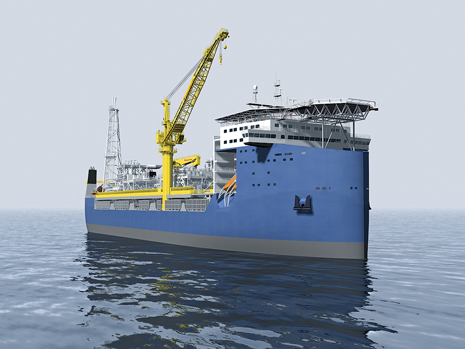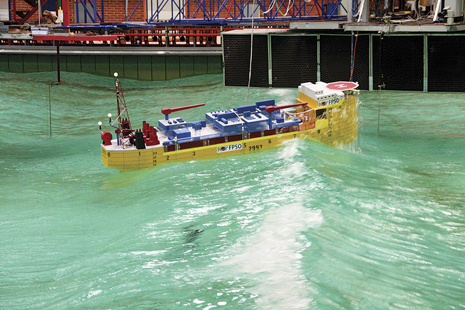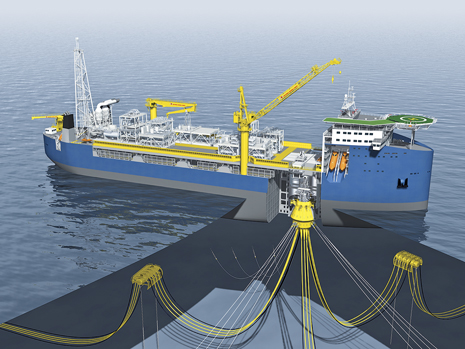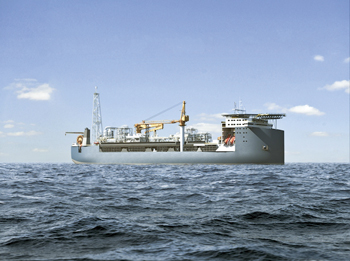GERALD MOSLEY, National Oilwell Varco (NOV)
 |
| NOV is taking a "game-changing" approach to building new FPSOs. |
|
Nature is full of countless examples of adaptation, from the long neck of the giraffe to the natural camouflage of a chameleon. Adaptation, loosely defined, is the ability to become better suited to an environment. In nature, it is a condition of survival.
The world of oil and gas production, specifically FPSOs, is in a transitional state. Increases in deepwater exploration and drilling over the past six-plus years have resulted in a large number of new discoveries, which will now require development solutions. Market forecasts1 suggest that there are more than 200 offshore oil and gas projects in the planning and study phases, which will require floating production solutions. The majority of these will likely be FPSOs.
The challenge going forward, although taxing, is exciting for the growth of the FPSO sector. In the past, the delivery record on FPSO projects has been generally commiserable, with many projects significantly exceeding both planned budgets and schedules,2 while the performance of FPSO units in service has highlighted problems with the integrity of the structures and the reliability of the vessel systems.
Of the 160-plus units in service, over 60% are based on the use of a converted oil tanker hull, that is to say a tanker hull is modified and the requisite mooring, hydrocarbon processing and utilities equipment is added to create an FPSO. The remaining FPSOs are based on newly built hulls, albeit some of these hulls are based closely on existing shipyard tanker designs. Many of the problems associated with the delivery and operation of FPSOs have their origins in a failure by the industry to properly comprehend the extent of the work required to convert a tanker into an FPSO, or in the case of a newbuild, to fully allow for the technical complexity involved in designing an FPSO from scratch. This is particularly true, when projects are undertaken in the harsher, more heavily regulated areas of the world, such as the North Sea.
This customary approach to FPSO development no longer meets the needs of our changing “environment.” The traditional “one-off,” highly customized approach to FPSO projects, with its poorly defined scopes, project budgets, schedules and resulting impacts, has spawned a supply gap that the market is ill-prepared to address. Yesterday’s solutions simply do not apply to the questions of tomorrow. The industry is ready for a technological “adaptation,” a mix of standardization and customization to deliver optimized results with highly predictable costs and schedules. Not a “one size fits all” approach, but rather, a configurable solution based on standardized components, an industrialization/adaptation of the current model.
National Oilwell Varco (NOV) and its partners have used over 15 years of North Sea operational experience to deliver the first in a series of game-changing solutions for the FPSO community, the Harsh Environment FPSO. The NOV design of a Harsh Environment FPSO is built with field-proven, high-spec equipment integrated into standardized, yet configurable, solution architecture. This gives operators confidence and flexibility. The HE FPSO is designed around the key features of safety, long-term reliability, and optimum operability and maintainability. The comprehensive suite of equipment is based on the strength of NOV’s expanded offering of internationally known and respected brands. This optimal balance of customization and standardization delivers the project and operational results that clients demand.
The HE FPSO is purpose-built for extreme conditions, with a design life of 25 years. To maximize efficiency and suitability, there are three vessel options available: 450, 650 and 1050 (reflecting storage capacity in thousands of barrels).
The standardized FPSO design delivers many advantages, including reduced interfaces, improved project execution, and streamlined delivery. The HE FPSO is designed around the philosophy of adding value through improved operational safety, integrity, reliability and reduced lifecycle costs to end-users and operators.
VESSEL BENEFITS
This vessel brings several benefits to the market, in the economic, efficiency and safety/risk-related categories.
 |
| Fig. 1. The HE FPSO has been designed and model-tested to comply with UK and Norwegian regulations for operational and safety parameters. |
|
Increased safety and lowered risk. The HE FPSO is designed with compliance in mind. Detailed compliance plans have been developed with the support of Det Norske Veritas (DNV). The vessel has been designed and model-tested to comply with both the United Kingdom (UK) and Norwegian Continental Shelf (NCS) regulations for hull Turret Mooring System (TMS) structure, stability, working environment, accommodation, layout and equipment, Fig. 1. The forward accommodation vessel layout provides personnel safe living/working conditions with ideal escape routes pre-defined. The vessel is also equipped with an APL Disconnectable Submerged Turret Production (STP) system for passive weathervaning, multiple fluid paths, and easy departure in extreme weather conditions. These features reduce risk exposure.
 |
| Fig. 2. One of the vessel’s benefits is superior fatigue life. |
|
Superior vessel fatigue life. The vessel’s innovative hull geometry (reduced overall length and low block coefficient) reduce hull wave bending stresses and improve hull fatigue life, Fig. 2. The raised bow and integrated accommodation reduce green water impacts. The design has undergone detailed model testing and obtained “approval-in-principle” from DNV.
Compact design. The HE FPSO’s cargo, ballast and void spaces have been arranged to provide maximum operational flexibility without sacrificing topside payload capacity. The 450, 650 and 1050 models support deck-mounted topside process and utilities equipment, ranging between 8,500 and 17,000 tonnes, while the 15 cargo tanks provide maximum operational flexibility. The topside layout is based on a standardized “footprint,” with configurable/scalable modules to keep sufficient flexibility to cater for a range of different types of process plants.
Maximized production uptime, minimized costs. As a newbuild vessel, the HE FPSO provides less unplanned maintenance (compared to convert FPSOs). High-specification coatings allow for no planned dry docking during 25 years. The design uses field-proven technology and high-specification equipment. The vessel’s layout and premium equipment selection support improved mechanical handling. The overall design is optimized for long-term reliability, thereby reducing life-cycle cost.
Reduced risk/Quicker delivery/Earlier first oil. The HE FPSO delivers reduced project risk by making schedules and budgets more predictable, and by incorporating compliance and certification requirements from inception. Utilizing configurable, scalable, pre-defined equipment packages leads to reduced interface concerns, more streamlined management and more effective project execution. All these things combine to provide cost-effective, quicker delivery and ultimately faster first oil.
 |
| Fig. 3. The HE FPSO is designed with redeployment in mind. |
|
Redeployment. The changing production environment also brings an increased demand for marginal to medium-sized developments. These projects have largely gone neglected, due to re-deployment concerns for field-specific FPSOs. The HE FPSO will address those re-deployment concerns with its standardized, configurable modules, and by beginning the design with the “end” (redeployment) in mind, Fig. 3.
Execution model (leverage what we’ve learned in drilling). NOV’s adaptive FPSO solutions are largely based on the model successfully implemented on the drilling equipment and services side of our business. NOV’s Production Solutions start with high-quality technology and field-proven equipment packages, where the individual equipment components are analyzed to find the proper combination to deliver standardized, yet flexible, design solutions. In addition, NOV’s engineering, fabrication, supply chain, and project management capabilities provide more predictability in execution. These strengths, coupled with NOV’s worldwide service, spares, and training facilities, provide clients the life-cycle support that they need.
Industrial partners. NOV is one member of a team of industrial partners, including shipyards, topside integrators, operators, etc., working together to form the foundation for answering the industry’s challenges. The shipyards, equipment suppliers and project teams benefit from the repeatability and constructability inherent in this approach, and can offer superior solutions at competitive costs and schedules.
What it’s not. The HE FPSO is not the “one size fits all” approach to standardization we’ve seen tried (unsuccessfully) in this space before. In those trials, the complete FPSO was designed and built before the field specifics were known. This resulted in fixed solutions with little or no flexibility. The “adaptive” approach is based on standardized marine and hull designs with flexible/configurable topside packages to fit field-specific needs.
The HE FPSO is not a move by NOV to enter the “design or operation” space for FPSOs. The HE FPSO is simply NOV’s attempt to introduce the adaptive approach to standardization to a community that has long been firmly entrenched against the notion of standardization. Specifically, the HE FPSO is designed to address the very specific needs of harsh environment regions (like the North Sea) that are underserved by today’s current solutions.
Early successes will be necessary for the offshore production community to embrace the concept of industrialized/adaptive standardization. We firmly believe that the HE FPSO will provide those successes and provide the necessary traction to further develop this approach into other regions.
Next steps. The HE FPSO is just the first in a series of possible game-changing solutions for the FPSO community. Other regions, like Brazil and West Africa, are excellent candidates for an adaptive approach to FPSO design.
In summary. Our market is changing. The FPSO supply gap is broadening. Traditional solutions will simply not meet the needs of these changing times. We need adaptive solutions to suit our new environment; industrial suppliers capable of delivering the entire FPSO scope with predictability and serving as life-cycle partners to the E&P and lease contractor companies. Solution partners who seek to standardize, to the closest degree possible; while balancing the trade-off between standardization and field-specific requirements. Not a “one size fits all” approach, but rather, a configurable solution based on standardized components.
NOV’s Harsh Environment concept is a critical first step to a more industrialized/“adaptive” approach to FPSO development. And while it may be short of a condition for “survival,” it is definitely a condition for “success.” 
REFERENCES
1. IMA estimate, November 2011.
2. Based on IPA’s analysis of 88 FPSO projects, the median FSPO project was 15% over budget, with an 18% schedule over-run. “Project management needs for FPSO projects,” David Rosenberg and Jonathan Walker, IPA, September 2012
|
The author
GERALD MOSLEY is vice president, Floating Production Solutions, at National Oilwell Varco (NOV). He joined NOV in 2001 and previously served as director, product line management, and program manager for offshore drilling projects. Mr. Mosley is a graduate of the United States Air Force Academy and holds an MBA from Colorado State University. |
|






